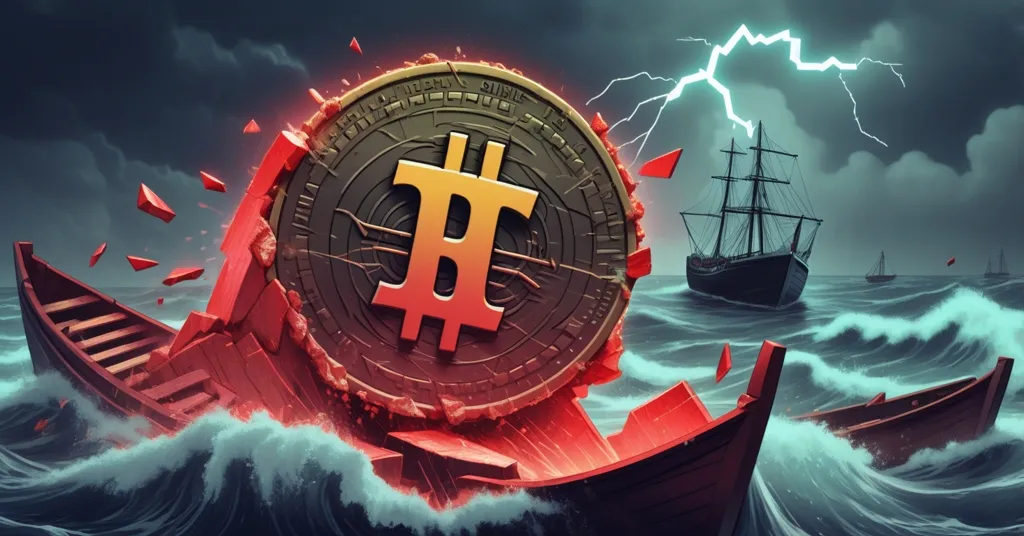Pi Coin Price Crash: Bearish Trend or Buying Opportunity at $0.61?

Pi Coin’s Price Plummet: Bearish Rut or Fleeting Bargain?
Pi Coin, the altcoin linked to the Pi Network’s mobile mining experiment, is stuck in a brutal downtrend, trading at a shaky $0.61 as of May 31 after six consecutive days of losses. With Bitcoin’s sluggish performance casting a shadow over the crypto market, is this just another altcoin getting crushed, or do oversold signals hint at a brief window for savvy traders to pounce?
- Price Snapshot: Pi Coin at $0.61, bleeding for six straight days.
- Market Drag: Bitcoin’s decline hammers altcoins, Pi included.
- Critical Levels: Support at $0.58 and $0.54; resistance at $0.65.
- Project Stumble: Pi Network’s endless mainnet delay tanks sentiment.
Breaking Down the Numbers: A Technical Bloodbath
Let’s get into the raw data on Pi Coin’s slide. As of May 31, the price languishes at $0.61, miles below its historical benchmarks—think a 50-day moving average (MA50) of $0.75 and a 100-day average (MA100) of $0.83. This isn’t a temporary dip; it’s a full-on collapse through key support levels that once held firm. Technical indicators on a 5-hour chart, pulled from sources like CoinMarketCap, are flashing “sell” signals louder than a foghorn at sea. Short-term averages (MA10 and MA20) are sloping downward, cementing the bearish vibe. But here’s a glimmer of something—metrics like the Relative Strength Index (RSI) and Williams %R are screaming oversold. In simpler terms, the price has been beaten down so hard that some bargain hunters might see it as a steal and step in soon. Still, don’t pop the champagne; in crypto, oversold can just mean a quick “dead cat bounce” before another drop.
For those just dipping their toes into crypto, let’s unpack a few of these terms. Support levels, like $0.58 and $0.54 for Pi Coin, are price zones where buyers have historically jumped in to stop further falls—think of them as a safety net that might not hold. Resistance, sitting at $0.65, is the flip side: a ceiling where sellers often take over, blocking any upward push. Moving averages smooth out price swings over time to reveal the trend—when the current price is way under these averages, it’s a glaring sign that sellers are running the show. And oversold? Picture a garage sale item marked down so low that someone’s bound to snag it, even if just for a quick flip. But crypto markets are ruthless, and these signals aren’t guarantees—just educated guesses.
Why do these levels matter? Well, $0.58 isn’t just a random number; it’s a psychological barrier where past trading volume spiked, suggesting buyers might defend it again. If it crumbles, $0.54 is the next line in the sand. Break past $0.65, though, and you’ve got a flicker of bullish hope. Problem is, with thin liquidity and speculative trading data, these numbers for Pi Coin aren’t as rock-solid as, say, Bitcoin’s price action on a major exchange. They’re more like whispers in a noisy room—listen, but don’t bet your life savings. For a deeper dive into Pi Coin’s past performance, check its price history.
Market Headwinds: Bitcoin’s Shadow Looms Large
Pi Coin isn’t crashing in isolation. Bitcoin, the heavyweight champion of crypto, is stumbling, and when BTC trips, altcoins like Pi get knocked out cold. Recent market data shows Bitcoin dominance—the percentage of total crypto market cap it controls—hovering around 61%. That’s a loud signal that investors are fleeing to the relative safety of BTC, leaving speculative tokens like Pi Coin high and dry. This isn’t new; history shows altcoins often bleed during Bitcoin bear cycles. Look at 2018 or 2022—altcoin seasons turned into altcoin massacres as capital rotated back to “proven ecosystems” like BTC or even Ethereum. Per CoinMarketCap’s Q1 2025 recap, major altcoins are taking brutal hits: Solana down 31.55%, Chainlink off 34.71%, even Ethereum cratering 43.85%. Pi Coin, with its tiny market presence and shaky fundamentals, doesn’t stand a chance in this storm. Learn more about how Bitcoin dominance affects altcoins.
Why does Bitcoin’s dominance matter so much? It’s simple—BTC is the original, the battle-tested beast with a decentralized network that’s survived hacks, bans, and FUD for over a decade. When markets get jittery, it’s the safe harbor. Altcoins, especially unproven ones, are like small boats in a hurricane—they might have cool ideas, but they lack the anchor to weather the chaos. As Bitcoin maximalists, we see this as validation: BTC is the backbone of this financial revolution. But let’s not write off every altcoin—Ethereum’s smart contracts and Solana’s speed fill gaps BTC doesn’t touch. Pi Coin’s mobile mining pitch could, in theory, democratize crypto access, especially in emerging markets. Too bad theory isn’t paying off right now. Curious about how Pi’s mobile mining works?
Pi Network’s Broken Promises: Hype Without Delivery
Now, let’s zero in on the real gut punch for Pi Coin holders: the Pi Network itself. Launched in 2019, this project sold a dream of making crypto accessible to the masses via smartphone mining. No expensive rigs, no tech know-how—just download an app and “mine” PI tokens. Sounds revolutionary, right? They racked up millions of users with promises of a new financial frontier. Fast forward to today, and the mainnet—the actual blockchain where these tokens would become usable and tradable—remains a ghost. Without it, Pi Coin is just a digital IOU, a placeholder with no real utility. You can’t spend it, stake it, or trust it. It’s often swapped on sketchy, unofficial markets with zero oversight, which explains the questionable price data we’re dissecting. Community frustrations are evident in discussions around Pi Network’s ongoing delays.
This isn’t just a delay; it’s a betrayal of the decentralization ethos we champion. Crypto is built on trustlessness—code over promises, transparency over PR. Yet Pi Network operates with centralized control pre-mainnet, deciding who gets what and when. Community skepticism runs deep; browse any crypto forum, and you’ll find Pi called everything from “a ghost ship with no captain” to a straight-up scam. Compare this to past altcoin flops like BitConnect or SafeMoon, where hype outran reality until the rug was pulled. Pi isn’t at that level—yet—but the parallels are eerie. Years of “soon” updates without a concrete roadmap have turned early enthusiasm into frustration. How can a project claiming to disrupt finance fumble something as basic as launching a functional network? For more on investor sentiment, see these community updates on mainnet challenges.
For context, Pi’s mobile-first approach still has a spark of potential. Bringing crypto to billions via smartphones aligns with broadening access, a goal we support in the spirit of effective accelerationism—pushing progress, even if messy. But potential means nothing without execution. Other projects have stumbled too, sure, but many recover by delivering. Pi Network needs to ship something tangible, or it risks joining the graveyard of good ideas that couldn’t cut it in crypto’s Darwinian arena.
Regulatory Red Flags: A Ticking Time Bomb?
Here’s another layer of risk that’s rarely discussed with Pi Coin: regulation. Altcoins, especially those trading as speculative IOUs outside major exchanges, are increasingly on the radar of global watchdogs. The U.S. SEC, EU’s MiCA framework, and other bodies have cracked down on tokens with unclear utility or centralized control—sound familiar? Pi’s unofficial trading markets could draw scrutiny before it even becomes a proper asset. If regulators label it a security or slap on trading bans, whatever value it has could evaporate overnight. This isn’t unique to Pi—many altcoins face similar heat—but its lack of transparency makes it a juicier target.
We’re all for disrupting the status quo and building a freer financial system, but ignoring regulatory realities is naive. Bitcoin’s strength lies partly in its resilience to such crackdowns; it’s too decentralized to kill. Pi Coin, tethered to a centralized project with hazy tokenomics, doesn’t have that armor. Investors need to weigh this sword hanging over its head. Could a legal hammer drop before the mainnet does? It’s a question worth asking in a market where governments are itching to rein in the wilder corners of crypto.
Price Scenarios: What’s Next for Pi Coin?
Let’s map out what might happen with Pi Coin in the immediate term. The bearish outlook, which feels most likely, points to a slide down to $0.58. If that support cracks, brace for a uglier fall to $0.54—a level that could trigger panic selling. A neutral scenario sees the price flatlining around $0.61, but only if the selling pressure takes a breather. On the bullish side, a long shot at best, oversold signals could spark a relief rally toward $0.65 resistance. As one market outlook noted:
For now, the bias remains bearish, but the oversold readings suggest a bounce could be near, even if short-lived.
That last bit is critical—short-lived. Even if Pi Coin catches a gust of buying, sustaining any gains without a broader market recovery or a bombshell update from Pi Network is pure fantasy. And let’s be real: the $0.61 price itself is shaky. Since Pi isn’t officially listed on major regulated exchanges, these figures come from speculative corners with low liquidity. Manipulation isn’t just possible; it’s probable. This isn’t the clean, transparent price action you get with Bitcoin on Binance or Coinbase. It’s more like betting on a horse race where the odds are scribbled on a napkin. Proceed with eyes wide open. For a detailed look at Pi Coin’s price outlook for May 31, there’s more to consider.
A Counterpoint: Could Pi Coin Surprise Us?
Let’s play devil’s advocate for a moment. What if Pi Network finally pulls it together? Imagine a mainnet launch in the coming months, packed with features that make mobile mining a gateway for millions in untapped markets—think regions where smartphones outnumber laptops but crypto adoption lags. Some optimists argue Pi’s accessibility could still carve a niche, especially if Bitcoin stabilizes and capital rotates back to oversold altcoins, as hinted by CoinMarketCap’s Q2 2025 outlook. Larger players like Ethereum have bounced back from rough patches by delivering utility; why not Pi? For a broader perspective on how Bitcoin’s decline impacts altcoins like Pi, the market dynamics are worth exploring.
It’s a fair point, but a distant one. Without concrete milestones or even a whiff of a timeline, this feels more like wishful thinking than a bet worth making. Innovation matters, and we’re all for projects that push boundaries where Bitcoin doesn’t. But in crypto, “what if” doesn’t cut it—show me the code, the network, the adoption. Until then, Pi Coin remains a gamble with odds stacked against it. Interested in current market trends for Pi Coin?
Key Questions and Takeaways on Pi Coin’s Struggles
- What’s behind Pi Coin’s ongoing price drop?
A mix of Bitcoin’s market weakness dragging altcoins down and Pi Network’s failure to launch a mainnet, leaving investors skeptical and selling off. - Could Pi Coin rebound in the near future?
Oversold indicators hint at a possible short-term bump, but lasting recovery needs a stronger crypto market and real progress from Pi Network. - Why are Pi Network’s delays such a massive issue?
No mainnet means no utility—Pi Coin isn’t a real asset yet, just a promise, clashing with crypto’s core of decentralization and trustless systems. - How trustworthy is Pi Coin’s reported price of $0.61?
Not very—it’s based on speculative, unofficial markets with thin liquidity, prone to manipulation, unlike Bitcoin’s more reliable exchange data. - Does Bitcoin’s dominance explain Pi Coin’s pain?
Yes, with BTC holding 61% of market cap, capital flows to safety during downturns, leaving unproven altcoins like Pi battered and bleeding value. - Are regulatory risks a concern for Pi Coin investors?
Absolutely—its speculative trading and centralized setup could attract crackdowns, a threat many altcoins face but Pi seems especially vulnerable to.
So, where does Pi Coin stand in this mess? It’s trapped between merciless market forces and self-inflicted wounds from a project that can’t seem to get out of its own way. For traders with an iron stomach, oversold signals might tempt a quick play, but long-term believers need more than hazy dreams to justify holding. As champions of decentralization and disruption, we see the appeal in experiments aiming to widen crypto’s reach—mobile mining could be a game-changer. But ideas alone don’t survive in this brutal space. Pi Network must deliver, or Pi Coin risks fading into obscurity among countless failed altcoins. Meanwhile, Bitcoin’s steady reliability towers over the chaos, a reminder that in this financial wild west, only the toughest endure. Will Pi adapt or crumble? That’s the multimillion-dollar riddle no chart can solve.



